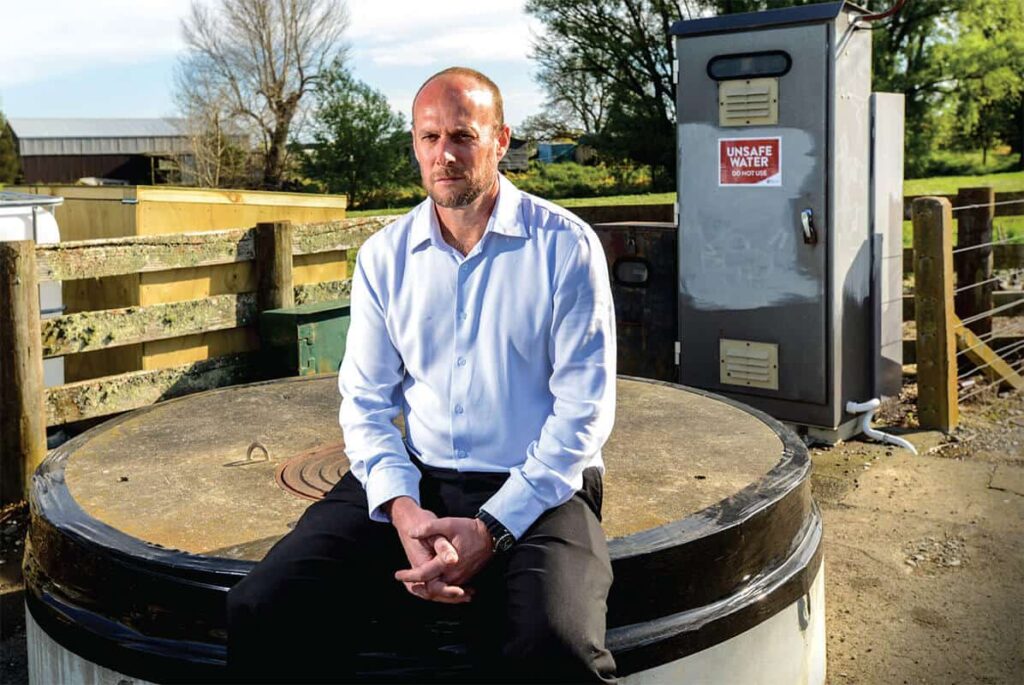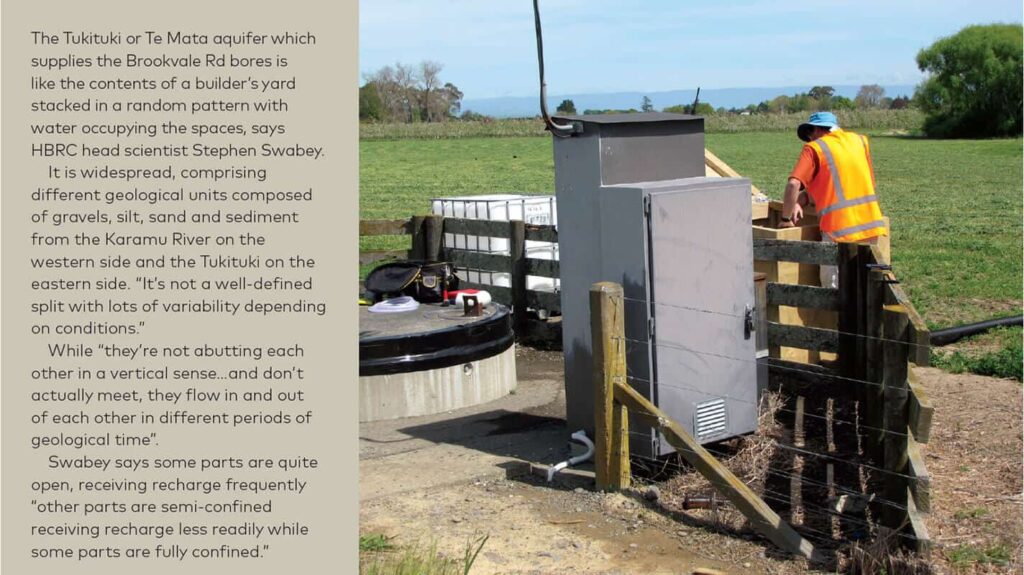As HBRC sees it, the most likely explanation for New Zealand’s largest water-borne contamination is that sheep poo, flushed from nearby grazing land into streams and surface water got into drinking water through a weakness in the Brookvale Rd bores or the Tukituki aquifer.
The term ‘perfect storm’ could describe the convergence; torrential rain after a long dry period, unresolved concerns about bore integrity, a silo approach to information sharing and a double power outage.
To test a pivotal theory, HBRC catchment engineers built a run-off model ‘re-creating’ 6 August. “We modelled the contour and elevation of the land, the amount of rainfall and where it would run through the downhill channels. Not surprisingly lots headed directly toward the bores,” says resource management group manager, Iain Maxwell.
He claims that during the weather event and power outage on Saturday 6 August the submersible pump in the dry cellar at the bottom of the No. 2 bore headworks and sump, managed by Hastings District Council (HDC), failed.
Hastings CEO Ross McLeod said back-up systems were working for sump pumps and flood alarms when inspected earlier in the year; there was no indication water got near the pump seals in August or evidence of cracks or water getting through the bore heads.
Maxwell told BayBuzz that in his understanding “no pumps of any description were working during the power outage as they rely on power to work”.
A September 26 report to council was even more specific: The pumps designed to remove “potentially contaminated water” from around the bore heads “do not have a back-up power source and did not run during the power outages”.
Delayed reaction
Critical questions about cause and culpability were still being asked and evidence sought as the Attorney-General announced a Government-led inquiry on 12 September, and 13 days later when HBRC announced its investigation into whether HDC had breached the conditions of its bore consents.
Was there a failure or weakness at the bore headworks about two metres below ground; had the metal casing been perforated through corrosion allowing water to get in, or had the contaminated drains and streams 50-70 metres away been sucked down from the surface into the bore or aquifer? Could recent earthworks in the vicinity have some part to play in allowing contaminated water into the aquifer?
If HDC was found to be in breach of consent conditions for the bores, at the very least it would get a stern letter, or HBRC could lay charges in the Environment Court threatening fines of up to $600,000. Hastings Council would be treated no differently than any company, says Maxwell.
While HBRC consents don’t require a bore to be fenced off or grazing animals to be kept a specific distance, Maxwell understands this is a requirement of HDC as water supplier and the Health Board as water assessor.
As the body responsible for ensuring its consents are complied with, does HBRC have to take some responsibility for checking the bores or if it is found that streams, groundwater and aquifer are potentially a cause of contamination?
“We regulate activities to protect the groundwater. There is no evidence that the groundwater is contaminated. Extensive testing has shown that there is no faecal contamination of the aquifer,” insists Maxwell.

HBRC tests the Heretaunga aquifer every three months for a range of parameters including pathogens like E.coli and “routinely tests” for a range of contaminants in groundwater; E.coli is used as a screen to indicate contamination and where appropriate further tests are done.
The HBRC investigation into causes of contamination was expected to be completed by mid-October and will ultimately inform the Government inquiry which will continue until early 2017.
Investigations from Hastings City, Hawke’s Bay District Health Board and the Ministry of Health are likely to become part of the inquiry, although HBRC could mount its own prosecution if it builds a case warranting enforcement.
Impatient waiting
Iain Maxwell was in spring cleaning mode, mowing his lawns and pruning his trees on the weekend of 13-14 August as the water crisis was escalating, and curious as to why he hadn’t been contacted by Hastings Council officers.
People became ill over the weekend of 6 August, the peak of campylobacter infections were reported on Monday and Tuesday, ahead of the ‘boil water’ warning then chlorination on the Friday, but still no word from HDC.
… contamination at the Brookvale No.2 bore in 1998 had been traced back to “sheep in a nearby paddock” after heavy rainfall. “Overland run-off had got into the cellar, flooding it and water had gone down into the headworks. When I heard that I thought that sounds like one of the pathways we’re looking at.” Iain Maxwell
Maxwell’s concerns escalated with media reports suggesting widespread contamination of the aquifer. On Monday morning he met with his environmental science manager Stephen Swabey and rang Hastings water services manager, Brett Chapman, to ask what was going on.
“We wanted to know what they were seeing…and what should we be doing to help them in their response.”
He wondered, was it a dead possum in the reservoir, had there been a spill or incident … leaching … had pipes been broken allowing sewage in? Did they understand what they were dealing with, how widespread was it and what needed to be done to contain and isolate the cause?
He knew he needed to act. HBRC rapidly deployed a dozen scientists; six from HBRC, four from Massey University and Environmental Science and Research (ESR) with expertise in climate, land use, water and environment, plus two dye tracing experts.
They started wide, sampling the Tukituki River and bores between there and Havelock North, then narrowing it down to streams and groundwater.
Dirty water dilemma
The first water samples were back from the lab on Thursday 18th. Although the Tukituki is a source of recharge for the aquifer, sampling showed “low levels of contaminants not unexpected at this time of the year”; the bores between the Tukituki and Brookvale were clear, says Maxwell.
Another two rounds of sampling eliminated groundwater at any depth but revealed “faecal material contaminants” in surface water, drains and streams, confirming the source was the two bores supplying Havelock North.
Tap-based monitoring by HDC and HBRC’s testing down to 20 metres in the bores confirmed low-level contamination.
A ruminant source was indicated in 80% of clinical cases. Deer were absent from the perimeter and dairying and beef were “tens of kilometres upstream in the Tukituki catchment”.
There’s no intensive land use around Brookvale Rd other than orchards, vineyards and “a few sheep grazing” and typically in Hawke’s Bay, says Maxwell, contaminants don’t leach down horizontally or vertically into the aquifer as they’re filtered out by layers of gravel.
Campylobacter pathogens are ubiquitous wherever animals are grazing and the minute menaces don’t survive long; four hours max, outside their warm blooded hosts. “The source has to have been fairly close to the bores,” said HBRC’s environmental science manager Stephen Swabey.
While the land had since been ploughed and put into crops the sheep were there during the August downpour. “Advice from microbiologists is that it doesn’t take a lot of campylobacter to infect this many people; about a kilogram in total would do it,” says Maxwell.
Based on evidence so far, run-off containing sheep manure got into the bore. The only way that could have happened, he says, is “the asset failed; that it wasn’t secure… contaminants leaked into the bore through some weakness.”
Prior warnings
The Brookvale bores had been in operation since the 1980s with consents only agreed to only after Hastings reluctantly conceded to HBRC and Ngati Kahungunu that it would seek an alternative supply before the expiry in May 2018.
The major concern raised was that the bores were having a detrimental effect on the nearby Mangateretere Stream. Hastings mayor Lawrence Yule had to be reminded of his undertaking by HBRC in February 2013, after objecting to spending millions of dollars of ratepayer money on a new supply when there was “plenty of water” for everyone.
There’s also a history of uncertainty about how secure those bores are. One of the three was shut down in October 2015 after E.coli was detected; a draft report from Tonkin & Taylor, released within days of the 2016 crisis, was inconclusive, alleging an undetermined source. Further investigation was recommended.
HBRC is looking into whether the closure of No.3 bore resulted in an increased draw from the Mangateretere stream, sourced by Tukituki-fed springs. Maxwell says there’s no evidence to corroborate claims of an increased flow in the stream since all the bores were closed.
Like others, Maxwell was surprised when a file note from the Ministry of Health revealed contamination at the Brookvale No.2 bore in 1998 had been traced back to “sheep in a nearby paddock” after heavy rainfall.
“Overland run-off had got into the cellar, flooding it and water had gone down into the headworks. When I heard that I thought that sounds like one of the pathways we’re looking at.”
Hastings CEO McLeod said in a statement that the 1998 investigations failed to definitively link the increased level of campylobacter cases to faults in the Brookvale bores. While the water supply was chlorinated at the time, he claimed suspicion also fell on the aquifer.
An insecure source
On 24 August HBRC became aware of a report from the Institute for Geological and Nuclear Sciences (GNS) indicating three bores including one in Brookvale Rd could “no longer be considered secure”.
HBRC was frustrated that Hastings received the report on 18 August, but failed to advise that ‘young water’ had been detected in the bores in May 2016.
It was also disclosed that the Hastings Water Safety Plan identified flooding of “dry chambers” at the well heads as a potential source of contamination. Other documentation described the chambers as “prone to flooding”, a possible source of previous contamination events, and the subject of historic concern by the District Health Board.
The day after it received that report, Thursday 25 August, HBRC announced its formal investigation into whether there had been a breach of consent, and to determine whether the Brookvale bores were sufficiently sealed and managed to prevent cross contamination.
Then a report tabled at an HDC meeting on September 15 indicated that around June this year, low-level contamination was detected in Havelock North’s water following multiple failures of a Te Mata Rd pipe that burst eight times in six days.
HDC officers said the mains had since been replaced and the incidents were coincidental.
As BayBuzz was preparing to go to press some parties close to the issue were consulting lawyers and refusing to comment further.
One long-time industry personality with intimate knowledge of aquifers said the matter was more complex than most people seemed to realise.
“Gravel is traditionally a marvellous filtering media, but it can vary in that it might provide good filtration in one area and not be so good 200-300 metres away.”
What concerned him was that nothing appeared significantly wrong when the bores were first investigated by both councils after the campylobacter outbreak.
“When I worked with the technical side of the New Zealand Apple and Pear Board we became concerned that orchardists were mixing chemicals near the wellhead of bores. Scientists told us it was possible for liquids to syphon down the outside of a well casing and get into the water table.” David Cranwell
Adding to the puzzle, he says, the No 3 Brookvale Rd bore shut down in 2015 was “the newest and deepest well with the best seal and should have had the least chance of contamination”, yet was affected first.
Based on the information to hand, the contamination appears to be coming from the aquifer, but like everyone else, he continues to wonder how it got in there?
David Cranwell of Te Mata Consultants who runs his own orchard and winemaking operations in the area adds his own views about potential causes of contamination.
“When I worked with the technical side of the New Zealand Apple and Pear Board we became concerned that orchardists were mixing chemicals near the wellhead of bores. Scientists told us it was possible for liquids to syphon down the outside of a well casing and get into the water table.”
He says the Brookvale Rd bores are old and shallow and “when you are syphoning off 20-30 million litres a day something’s got to give.”

What it’s not
In mid-September Stephen Swabey’s science team at HBRC and their expert consultants were still testing “any and all plausible possibilities”, with the bores at the centre of the investigation.
They were putting coloured dye into the Mangateretere Stream then pumping the bores as usual to see “if the dye pops up showing that its feasible for stream water to have made its way into the bore face”.
Potential leakage from offal pits and sabotage have all been eliminated as potential causes; “it doesn’t make sense for someone to drop poo down a bore…you’d really have to know what you’re doing”.
Horizontal drillers damaging sewer or water pipelines while laying ultrafast broadband (UFB) cables have been discounted. “If there was a problem in either of those networks they’d figure it out because they need to be under pressure,” says Maxwell.
Even a trickle from a cracked sewer pipe wouldn’t account for the outbreak because it’s human excrement. “We’ve been all over the landscape …and we’ll keep looking in case there are multiple sources.”

Claims that deep cracks or fissures in the clay surface could have allowed contaminants to get into the aquifer are rejected. “We would not agree that this is a pathway,” says Maxwell.
“There is no evidence of there being ‘deep cracks’ in the ground that extend right into the aquifer. This aquifer consists of layers of gravels rather than clays. There are many metres of gravels in the area and some deeper layers of thick clay, but these are well below the ground surface and in isolated areas.”
The initial kick back from some critics was that HBRC was being heavy handed in demanding 20-years of data from HDC around use of the Brookvale bores. “I make no apology for that. We had to work hard to get that data and we probably still haven’t got all we need,” says Maxwell.
“We understand they have a job to do as water supply manager but we needed to look closely at the integrity of the infrastructure … to count it in or out … that’s our job … It’s a big complex jigsaw and every bit helps.”
Careful legal review
After being shut out of the initial conversation, HBRC executive team was moving swiftly. The first week’s timesheets recorded 900 ‘man hours’ and by early October that had nearly trebled.
On 28 September councillors were updated on the forensic sequel to the dirty water drama, and asked to retrospectively approve the actions of its officers including signing off $377,936 on staff salaries ($177,000) and $201,000 to cover external contractors, laboratory time and legal expertise.
A “careful legal review” of all evidence was necessary “to determine whether a case for further action is warranted” for its own investigation and to prepare for the Government Inquiry.
Additional funds came from an operational surplus, existing budgets and the regional disaster reserve which at the time was $3.5 million. It was hoped some costs might be recovered, if a successful prosecution were undertaken.
The terms of HBRC’s investigation were carefully worded to include “any potential breach of resource consent by any relevant party” including “any historical or contemporary actions by the Council that may have contributed to the contamination”.
Councillors were told events leading to the contamination may span years or even decades and a thorough review of past actions, historic documents and files and interviews with current and former staff would be necessary.
Maxwell says any idea that HBRC is simply covering its backside by investigating Hastings infrastructure is a ridiculous notion; his council was simply carrying out statutory obligations that would be under intense scrutiny.
“We’re only interested in what happened, how it happened and how we stop it from happening … so you have to ask why on earth we would try and screw the scrum?”
That kind of thinking is “really unhealthy” he says. “We would be asleep at the wheel not to do this. We’re being thorough and careful. We have no desire to drag this out.”
Legal battle ahead
Regional council responsibilities are also likely to come under the magnifying glass of the inquiry, including its role in “monitoring and maintenance of water quality”, managing discharges on land that may have an adverse impact on that quality, administering bore permits and resource consents, and ensuring compliance.
Questions are also likely to be raised about whether earlier warnings of low level contamination and the state of piping and seals were taken seriously enough? Did silo thinking and patch protection prevent a more rapid response and was there adequate and timely communication with those most affected, the people of Havelock North?
Clearly HBRC is ready for the most serious of options having retained luminary lawyers Chen Palmer to represent their interests in the Attorney- General’s Inquiry which is expected to report back by 31 March 2017.
Depending on results of its own investigation, HBRC may pre-empt that process and file proceedings against Hastings District Council in the Environment Court, placing the Government Inquiry on hold.
As Ian Maxwell says, there have been issues with drinking water for some while, but the scale of what happened in Havelock North will force change in legislation, best practice or both. “Potentially new agencies will do some work … there’ll be a raft of things. I’ll be floored if nothing changes.”

